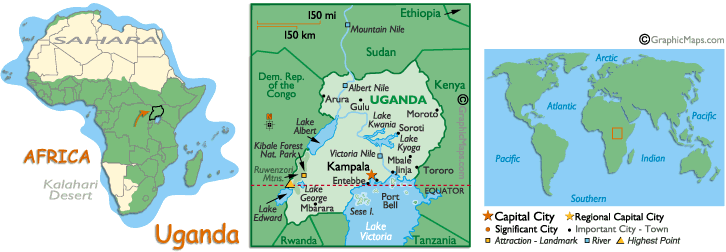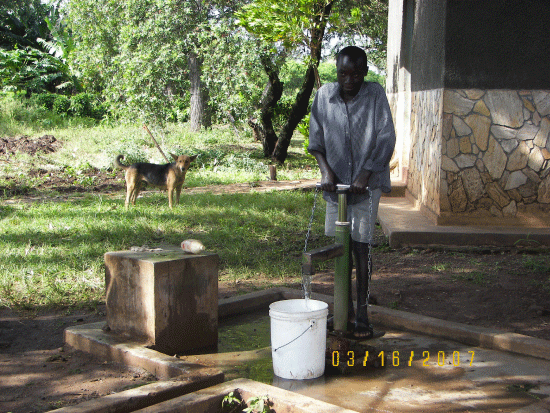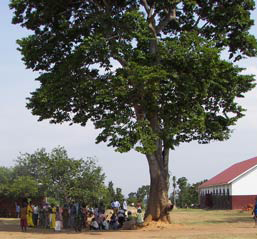Uganda is a land-locked country that sits on the equator in sub Saharan East Africa. Its neighbors are the Democratic Republic of Congo on the west, Sudan to the north, Kenya on the east and Tanzania to the south with just a small corner in the southwest connecting to Rwanda.

John Paul School is located in a small village.
Pallisa
The Pallisa District is north of the capital city of Kampala and has a population approximating 500,000. Within the district the town of Pallisa has a population of 20,000 scattered across the surrounding 10 km area. This is a rural area with a lot of subsistence farming and extremely limited public transportation.
Chelekura
Chelekura is a very small village located in the “Heart of Africa”. It is seldom depicted on maps and you have to really persevere to find anything about the area, most times googling it will be unsuccessful. It is in the Pallisa District and it is located about 20 km northwest of the town of Pallisa. There is no established town or village but more an area with a collection of tribal groups that are subsistence farmers.
Climate
The country’s equatorial location and high average elevation bless Uganda with a pleasant tropical climate and ample rainfall throughout the year. There are two rainy seasons. The first occurs between March / June and a second happens during August / September. In spite of this, providing readily available safe drinking water to the populace is a major problem. Average daytime highs range between 68 - 86 F.
Geography
The terrain within Uganda varies greatly. Not far from Chelekura is Mount Eldon, the second highest mountain in East Africa with an altitude of 4,700 meters. In the immediate Chelekura area however the land is relatively flat with low gently rolling hills and a rocky terrain.
Agriculture
More than 90 % of the employed in the rural communities around Chelekura are engaged in agriculture and the majority of those are small subsistence farms. In general women contribute most of the farm labor. Crops consist mainly of: cereals (maize, millet, rice), legumes (groundnuts, soybeans, green beans), and root crops (cassava, yams, sweet potatoes, and bananas). The only cash crop which is grown is cotton.
Water
Urban areas and communities where there are governmental offices generally have access to potable water. In rural areas however obtaining clean water is often a daily, time consuming struggle.

If there is a local bore hole, people (generally children and women) walk many miles daily to que up in long lines waiting their turn to fill their bright yellow jerry can and then start the long walk home carrying the heavy water cans. This daily migration of countless people walking the roads with their big yellow cans is a too common sight in all of Africa. If there is no local bore hole, people must depend on water from lakes, rivers, and streams. This water source is often contaminated and the source of many water borne diseases. Schools establish wells so that children have access to good drinking water and people that live in the vicinity of these schools are also able to benefit from this water source. However, establishing a well is an expensive proposition. The current cost is approximately $7000. At John Paul Secondary School we drilled for water seven times and were unable to find a source of water. Ultimately we installed a 18,000 litre cistern and water collection unit to take advantage of the twice seasonal rains to provide good water.
Education
The first schools established in Uganda were mission schools started during the 1890’s. As a British Colony, education of native peoples was not a priority and it took until 1924 for the first secondary school for Africans to be built by the government. However by 1950 the government had basically ceded secondary education to religious organizations and only three of the fifty-three secondary schools for Africans were operated by the government. During the 1970’s and 1980’s the education system suffered from economic decline and political instability. School maintenance standards suffered teachers fled the country, morale deteriorated, and many facilities were damaged by warfare and vandalism. In 1997 free primary education was made available for four children per family. And in 2006 education was given a huge boost when President Museveni mandated government supported primary education for all boys and girls, urban and rural alike. Still only about 40% of primary school graduates go on to any form of secondary education. Ugandan children have been victims of poverty, disease, ignorance and the ravages of guerilla warfare for decades. Education is the key to their salvation, both physically and morally. Now they are getting an opportunity to get that education. But there are still many challenges. There are not nearly enough facilities and they are often in disrepair, are incredibly overcrowded with some classes in primary school reaching 120, lack scholastic materials, and lack the technology taken for granted in the Western world. |

